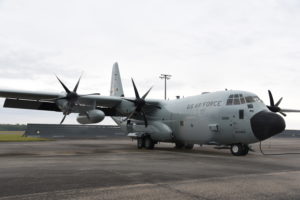
The 53rd Weather Reconnaissance Squadron, commonly known as the “Hurricane Hunters” are going vintage, at least with the paint scheme on their aircraft. The first of the 10 WC-130J Super Hercules aircraft returned to Keesler Air Force Base, Miss., April 5, with the shiny paint job and the historic “Weather” tail marking. The aircraft will fly into tropical disturbances, tropical storms, and hurricanes in the coming weeks and months while also conducting other weather-related research missions in the off-season from the hurricane season.
“Prior to 2007, the squadron’s aircraft all had glossy gray paint, which was used on weather reconnaissance aircraft, primarily for its durability, longevity, and efficiency,” said Lt. Col. Erik Olson, 53rd WRS director of operations. “It also differentiates our platform from ready-for-combat C130 aircraft and especially ‘other’ reconnaissance platforms, since our missions are strictly for peacetime weather data collection.”
The Air Force Reserve’s 53rd WRS is the only Department of Defense unit that provides surveillance of tropical storms and hurricanes in the Atlantic Ocean, the Caribbean Sea, the Gulf of Mexico and the central Pacific Ocean for the National Hurricane Center in Miami. The data collected by the 53rd WRS during tasked missions is shared with government and meteorological agencies in those regions helping the people of those areas be better prepared and make better decisions when hurricanes approach.
“Providing this timely data is made more effective through cooperation with foreign governments, whether coordinating overflight to minimize enroute time to working diplomatic clearances in order to fly a hurricane to landfall inside territorial waters,” said Lt Col Byron Hudgins, 53rd WRS chief pilot. “The return to the gloss gray paint scheme changes the look from a tactical purpose and is a visual reinforcement to those governments that the WC-130J is there to help.”

“We are more than just the ‘Hurricane Hunters,’ and the tail flash of ‘Weather’ better represents our multiple missions,” said Olson. “We also fly reconnaissance into winter storms in the North East and into atmospheric rivers on the West Coast collecting weather data year-round to improve forecasts.”
“The glossy gray paint scheme held up much better to the weathering elements during hurricane season than our current tactical gray paint scheme does,” said Senior Master Sgt. Stephen Connors, 403rd MXS fabrication flight chief. “And when it comes to maintenance and touch up painting, the glossy gray lasts longer.”
According to their technical data, the maintenance section found the tactical gray required touch up painting on the leading edges of the wings and on the vertical tail fin after each two-week storm rotation as compared to three to four storm rotations for the glossy gray.
“Going back to the glossy paint saves us money and manpower,” said Connors. “Also, the damage caused during the weather flights to the tactical gray paint would sometimes go all the way down to the metal, where the same type of weather damage to the glossy gray paint doesn’t have the same effect.”
Connors also said that the aircraft are set to follow their normal routine repaint schedule, while touch up will be handled by the fabrication flight.
“I am really excited to see it go back to the old paint scheme. It actually makes a lot of sense financially. The Air Force Reserve ultimately saves money on repainting, because the glossy paint lasts longer,” said Maj. Gen. Jay Jensen, Air Force Reserve Command special assistant to the AFRC commander, after seeing the newly painted WC-130J.
“I am loving the old-school look, goes back to the E-models with the ‘Weather’ markings,” Jensen said. “It is good to see that heritage and tradition return.”
The Hurricane Hunters’ first flight into a storm occurred in the summer of 1943, during World War II. At that time, a hurricane was threatening (and eventually struck) the Houston metro area. That summer, British pilots were being trained in instrument flying at Bryan Field. When they saw that the Americans were evacuating their AT-6 Texan trainers in advance of the hurricane, they began questioning the construction of the aircraft. Lead instructor Colonel Joe Duckworth took one of the trainers out and flew it straight into the eye of the storm. After he returned safely with navigator Lt. Ralph O’Hair, the base’s weather officer, Lt. William Jones-Burdick, took over the navigator’s seat and Duckworth flew into the storm a second time.
This flight showed that hurricane reconnaissance flights were possible, and further flights continued occasionally. In 1946, the moniker “Hurricane Hunters” was first used, and the Air Force and now Air Force Reserve have used it ever since.
The 2022 Atlantic Hurricane Season, as well as the 2022 Central Pacific Hurricane Season, begin on June 1 and continue through to the end of November. The 2022 Eastern Pacific Hurricane Season begins slightly earlier on May 15. The Hurricane Hunter aircraft is deployed in any of the three basins as conditions warrant.